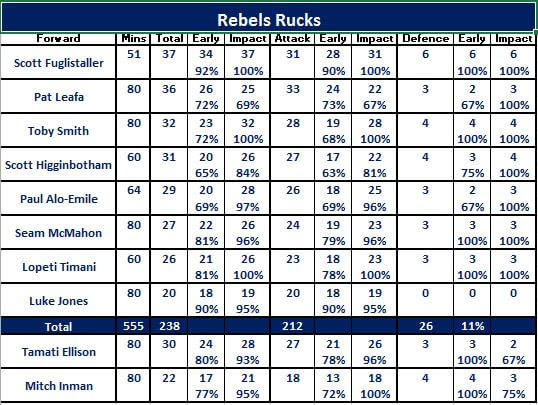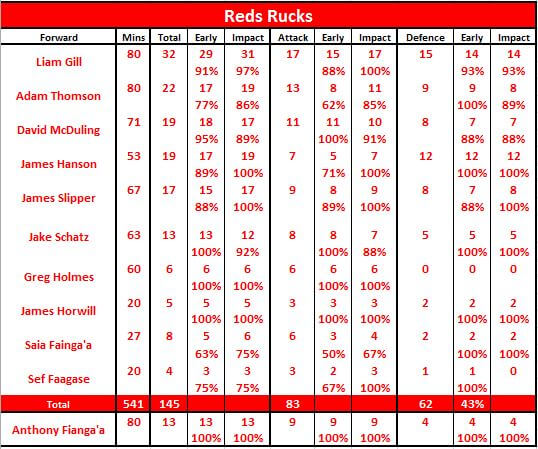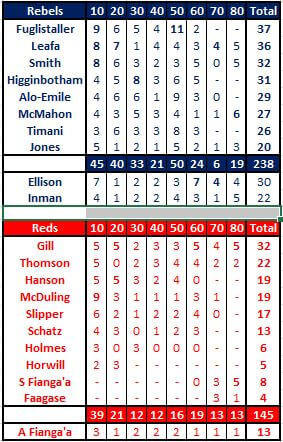An unconvincing effort by the Rebels resulted in a win and a final scoreline of 23-15 despite the Reds being reduced to 14 men after the first 20 minutes (Horwill – Red Card) and the Rebels having 72% possession and 80% territory in the 2nd half. The Reds were very much in the game up until the Rebels’ 3rd try at the 66th minute.
The Rebels maintained good ball retention, however the Reds put in a strong defensive effort with the scores locked at 15-15 for 37 minutes. The Reds’ scrum held its own despite being a man down for most of the match.
The Rebels ball carriers (173 carries for 667m) had the Reds defense under pressure with 22 clean breaks and 15 defenders beaten.
Remember:
- Early means 1st or 2nd AFTER the ball carrier has been tackled and brought to ground.
- Impact means active engagement: strong physical contact, changed shape of ruck, clean-out, protecting ball etc. (more than hand on someone’s bum or arriving after the hard work has been done). Yes it’s subjective – but as I collect all data at least it’s consistent.
- Impact DOES NOT equate to Effectiveness. I’ve concluded that coming up with an effectiveness measure is just too hard in the time that I have available – but open to suggestions.
REBELS v REDS – WHAT DO THE RUCK STATISTICS TELL US?
Comments:
- Ruck involvement by the Rebels forwards showed very strong support for the ball carriers. Rebels forward rucks in attack outnumbered rucks in defense by about 8:1. Rebel forwards generally held off on defensive rucks, gaining only 2 turnovers from 26 defensive ruck involvements.
- Ruck involvement by the Reds forwards was severely restricted by lack of possession – particularly in the 2nd half (28%). Ruck engagements in defense almost matched ruck engagements in attack. The Reds forwards gained 6 turn-overs (Gill 4) from 62 Defensive ruck involvements.
- Scott Fuglistaller had the most ruck engagements (37); closely followed by Pat Leafa (36).
- However, Liam Gill was the standout rucking forward (32 rucks) and No 7 due to his 4 turnovers won, game-high 20 tackles (95%), zero penalties and better running game (6 runs for 19m, 2 defenders beaten and 1 clean break).
- Scott Higginbotham outpoints Jake Schatz as No 8 due to his high level of ruck involvement and ball carries (7 runs for 14m). Jake Schatz was fairly quiet after suffering what appeared to be a serious elbow injury early in the 2nd term.
- Sean McMahon outpoints Adam Thomson as No 6 due to his strong support of the Rebels ball carriers and strong ball carries (12 runs for 64m, 3 defenders beaten). Adam Thomson’s tackling continues to be a feature of his game (17 tackles at 89%).
- Lopeti Timani outpoints Luke Jones for the best performing lock for his 60-minute rucking effort; as well as 8 tackles (80%), 7 runs for 12m, 1 try.
- The Rebels front row showed strong support of ball carriers with almost double the number of ruck engagements of their Reds counterparts. Pat Leafa had the most ball carries (11 for 12m) but also 3 missed tackles and conceded 5 penalties. Greg Holmes had the least ruck involvement (for 60 mins) of all forwards.
- The Rebels Backs showed a high level of ruck involvement with Tamati Ellison and Mitch Inman each having more ruck involvement than most Reds forwards. Commendable efforts by Naivalu, Harris, Reid and English.
- Anthony Fianga’a was the only Reds back who showed any consistent ruck involvement.
THE FOLLOWING TABLES SHOW RUCK INVOLVEMENT FOR EACH 10-MINUTES OF THE MATCH.
Comments:
- Commendable near-80 minute efforts by Fuglistaller, Leafa, Smith, Gill and Higginbotham .
- Some big efforts (ruck/minute) by the Rebels forwards in the opening 20 mins and 40-50 mins.
- Outstanding 10-min efforts by Fuglistaller, McDuling, Alo-Emile, Leafa, Smith, Timani and Higginbotham.
Other significant ruck efforts:
Rebels
Sefanaia Naivalu – 19 rucks (79%/100%)
Mike Harris – 14 rucks (79%/100%)
Jordy Reid (29 min) – 13 rucks (85%/92%)
Tom English – 12 rucks (92%/100%)




